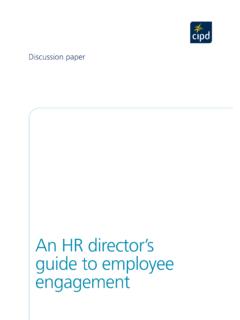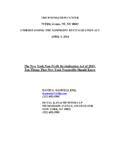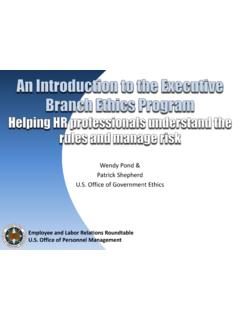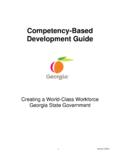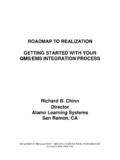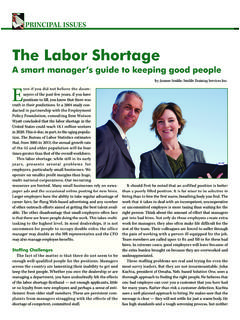Transcription of Documenting Discipline and Performance Issues
1 Documenting Discipline and Performance Issues Andrea Giggetts Giggetts and Associates (904) 742 6105 for Georgia Community Action Association Thursday, July 28, 2011. 1 Program Agenda Why Managers Hate to Document? Did You Know? Documenting Employees' Performance Documentation Examples of Documentation Analyzing Discipline Problems Performance Appraisal Program Assessing an employee 's Performance Checklist of Factors that Distort Performance Appraisals Coaching/Counseling Employees Preparation from an employee 's Perspective The first responsibility of a leader is to define reality. The last is to say thank you. In between, the leader is a servant. Max De Pree Leadership Is An Art 2 Description of Workshop This course is designed to assist front line supervisors in conducting employee Performance appraisals and Documenting Discipline . Goals What Do I Want You to Achieve From This Seminar?
2 Upon completion of this course of instruction, the supervisors should be able to: Document the Performance plan Coach, counsel, and provide feedback to employees Document an appraisal Communicate effectively to employees about Performance problems and Performance improvements Knowing how to do a job is the accomplishment of labor. Showing others is the accomplishment of a teacher. Making sure the work is done by others is the accomplishment of a manager. Inspiring others to do better work is the accomplishment of a leader. John Maxwell 3 Andrea's MOTTO Remember it tomorrow by writing it down today! 4 Unwanted List! (WHY DO MANAGERS HATE TO DOCUMENT?) 5 DID YOU KNOW?? You NEVER WIN an employee lawsuit. Even if the judgment is in your favor, the legal costs are very expensive. Other costs include emotional drain, employee turnover and lower morale.
3 6 10 WAYS TO AVOID LIABILITY document document document Document Document Document Document Document Document DOCUMENT. 7 SEVEN REASONS FOR Documenting EMPLOYEES' Performance 1. Prevents later denial 2. Aids your memory 3. Minimizes misunderstandings 4. Stimulates thoughtfulness 5. Reveals patterns 6. Covers your absence 7. Supports future evaluators 8 HOW JURORS VIEW THE EMPLOYER'S DOCUMENTATION OF Discipline To fully understand how jurors view the documents of any disciplinary action, put yourself in the shoes of a juror hearing an employment matter filed in a current or former employee . The juror knows that by the time the witness takes the witness stand, he/she has met with the attorney to rehearse the testimony. That explains why what is said after the fact is a poor substitute for a document that expresses the thought processes and conclusions, the discussions with the employee , and what was agreed to and acknowledged at the time you were dealing with the problem.
4 While the jury will have no written record of your testimony, that document prepared at the time of the incident could well become an exhibit at trial one that will go into the jury room for examination by the jurors during their deliberations. How do you want that document to read? Will it reflect that you have given the employee due process? That you took the time to explain how you were arriving at a fair decision? That you took the time to explain the business purpose behind your action? Do it now! Do it when your motives are not suspect. Allow the juror to walk in your shoes and to see things from your point of view. If you can do this, the juror will be less likely to second guess your decision. More important, if the document is truly jury friendly, the employee will be less likely to take such a case to an attorney and litigation will be avoided.
5 The moral is: What you do and say today must be done with a view toward what you would say if ever called to testify before a jury. Allan L. Rolnick 9 HOW EMPLOYERS CAN UNDERSTAND AND RESPOND TO THE NEW LITIGATION PARADIGM Why does the litigation of employment cases differ from commercial lawsuits or other types of business related litigation? Why will the numbers of employment lawsuits increase next year and what can be done to protect against the cost of such litigation? The answer to both questions comes from understanding the new paradigm and changing the approach to employee discharge and Discipline so that documents are drafted according to a fair and deliberate process designed for jury comprehension. Changing employment laws and related government enforcement efforts, as well as corporate attention to the new efficiencies brought about by global competition, have constructed this new paradigm.
6 The changes in the workplace have led to employee insecurity. Even within employment settings which have not actually experienced a reorganization, employee loyalty has been influenced by reductions in force affecting other family members, acquaintances or friends. The previous social compact whereby the employee was guaranteed a job as long as he performed up to standard has been cast aside. Many employees now feel that management's verbal commitments to employees as the Company's most valuable resource are consistent with its actions. The result is more job insecurity, less loyalty to the employer, and a greater propensity of employees at all levels to consider the filing of discrimination charges and lawsuits. When employee insecurities from a changing work environment are coupled with the advent of jury trials of employment cases, we have yet another new paradigm.
7 Attorneys that represent plaintiffs in employment cases are becoming more selective in the cases they handle. These lawyers are aggressive and understand the dynamics of juror reaction to employment cases. Since current remedies are capped, settlements are encouraged because both the plaintiff and the attorney know that the federal law prevents a big payday. Thus, almost every federal complaint contains state tort claims as well. Many employers currently buy their way out of potential lawsuits with severance packages in exchange for executed releases of liability. However, employer generosity seems to reduce with each downsizing and the lack of transition assistance further exacerbates the loyalty crises. We can anticipate an effort to persuade Congress to remove the caps on punitive damages for discrimination matters. If successful, employees will be less inclined to accept reduced packages and plaintiffs' attorneys will have a disincentive to settle employment matters an incentive to take their chances with a jury.
8 We can anticipate an increase in cases brought by employees affected by management's continued downsizing and an increase in jury trials as plaintiff's attorneys pursue the pot of gold made available by punitivedamage 10 opportunities either created by new legislation or arising from state tort claims appended to federal claims. Jurors tend to give the benefit of the doubt to the employee and regard the employer's deep pocket as a source to rectify perceived injustices. This new dynamic makes it imperative that management revise its disciplinary policies and procedures so that the methods used ( , the bedside manner of the officials who communicate employment decisions) and the disciplinary documentation clearly convey the business reasons behind decisions to terminate the employment relationship or to promote, or demote, or reassign job duties.
9 Juries concern themselves with fairness. Therefore, management's methodology becomes a critical walk in the shoes of the decision maker, juries will tend to side with the employee and punishing employers with punitive damage verdicts. Jurors are more likely to read documents and less likely to credit management's verbal testimony at trial. Jurors rarely resolve credibility conflicts in favor of employers. Therefore, proper documentation and a fair and deliberate procedure become the best defense against adverse jury verdicts. Employers must recognize why settlements will be fewer, why more cases will be litigated before juries, and why state punitive damages claims will result in increasing jury verdicts. Employers must re write documentation requirements and procedures to insure the appearance of fairness or they will find themselves unprepared to respond to these shifting paradigms.
10 Allan L. Rolnick 11 DOCUMENTATION Effective Documentation: A Key to Winning Lawsuits The documentation should also have a statement regarding Employment Records Closely Scrutinized any employment rule, policy or practice regarding the Recent court decisions and jury surveys indicate the rule tells the decision maker that the that judges and juries look closely at employment employer has a clearly articulated position and that the records before making a decision. If facts are in employee is on notice that he or she is not satisfying dispute, great weight is often given to written requirements. documentation in resolving the dispute. Employers who have established a format for written An important item often overlooked by employers is a documentation also realize a consistent and high statement telling the employee how his or her action had a quality written product helps focus management's negative impact on business operations.
